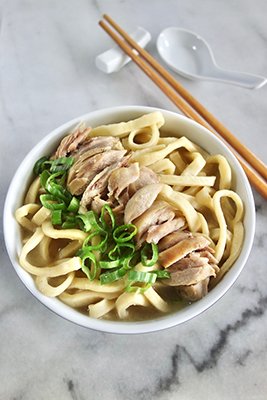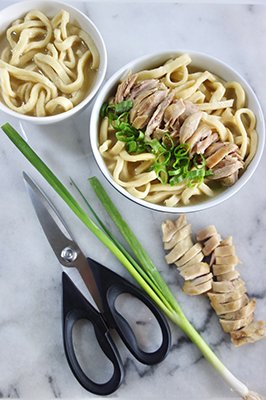My Easy Homemade Mami Recipe
The Happy Home Cook features cherished recipes of Filipino dishes from well-known foodies and contributors. If you have a recipe that you are proud of and would like to share, please send it along with a photo of the dish, your two-sentence bio and your picture to submissions@positivelyfilipino.com.

(Photo by Claire Mercado-Obias)
Preparation Time: 45 minutes, plus 30 minutes dough resting time
Yield: 2 servings
Ingredients:
Noodles
5 ounces (140 grams) bread flour or all-purpose flour, plus a bit more for adjusting and dusting
¼ teaspoon salt
1 medium-sized egg (room temperature)
5 teaspoons (1 tablespoon + 2 teaspoons) water
Soup
2 ounces (50 grams) shredded, cooked chicken meat (optional)
1 bunch baby spinach (trimmed, washed, and drained)
2 tablespoon chopped scallions
2 teaspoons sesame oil
20 ounces (600 ml) chicken stock (simmering)
Procedure:
Make the Noodles
1. In a big bowl, add flour and salt. Mix together with a fork.
2. Crack the egg into a small bowl. Add the water, and whisk with the fork. Pour into the flour and salt mixture, and stir with the fork until well combined.
3. Grab a handful of the mixture with your hand. Squeeze tightly and release. The dough should fall off you hand completely. (If not, add a tablespoon more of flour to the mixture. Blend well with your hand. Repeat step 3.)
4. Keep squeezing the mixture together in the bowl for about 5 minutes or until it all becomes one big dough. Form into a ball, and wrap tightly with plastic wrap. Let dough rest for 30 minutes.
5. Unwrap the dough, and lay it on a clean flat surface. Knead (push, fold, push, fold) the dough with your hand until the dough is completely smooth, about 10 minutes. Flatten and form into a squarish shape.
6. Sprinkle the dough lightly with flour. Spread flour all over the surface of the dough with your hand.
7. Using a rolling pin, roll the dough out into a large squarish-shaped sheet with sides of at least 10 inches (25 cm) long. (This requires at least 10 minutes of muscle power!)
8. Sprinkle the dough lightly with flour on each side, and spread the flour evenly with your hand.
9. Fold half of the dough over the other half without pressing. Sprinkle lightly with flour. Fold over again in half without pressing. Sprinkle again lightly with flour.
10. Find an adult to work with you. Ask the adult to slice the dough crosswise (across the folds) into extremely thin (about 2 mm) strips using a sharp knife. Sprinkle the cut noodles with flour, and toss to loosen the noodles. (Optional: Unfurl each strand, and stretch gently without breaking.)
11. Bring water to a boil in a big pot. Drop the noodles in boiling water and stir. Cook for 2 minutes. Drain.

“Mami" was also called “gupit,” Tagalog for cutting with scissors. Ma Mon Luk cut the noodles according to how much his customers could afford. He also cut the chicken with scissors, his secret to keeping the meat juicy. (Photo by Claire Mercado-Obias)
Make the Chicken Noodle Soup
1. Divide the mami noodles in two bowls.
2. Top with chicken (if using), spinach, scallions, and sesame oil.
3. Ask an adult to ladle the simmering chicken stock into the two bowls. Serve hot. Enjoy!
For more on Jacqueline Chio-Lauri’s book: https://ift.tt/im2wkWo

Jacqueline Chio-Lauri is the founder of My Food Beginnings, a project endorsed by the Philippine Embassy in the US, to fire up an appetite for Filipino cuisine globally. Jacqueline is soliciting real-life stories with reinvented recipes for the forthcoming Filipino food anthology.
More from Jacqueline Chio-Lauri
No comments